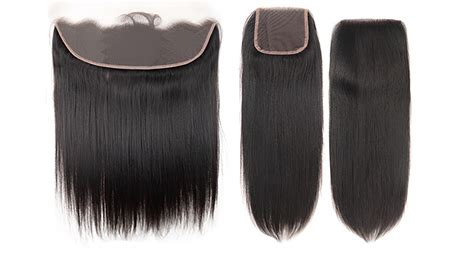Introduction
In the vast world of hair extensions, two distinct styles stand out: closures and frontals. Both have their unique advantages and drawbacks, catering to specific hair needs and preferences. In this article, we delve into a comprehensive comparison of closures vs frontals, exploring their key features, benefits, and suitability.

Understanding Closures
A closure is a small, semi-circular hairpiece that covers the top of the head. Unlike wigs, closures do not cover the entire head but instead create the illusion of a natural scalp by blending seamlessly with natural hair. Closures come in various sizes, ranging from 2×2 inches to 6×6 inches, and can be attached using glue, tape, or clips.
Key Features:
- Partial coverage: Covers only the top of the head.
- Creates a natural-looking scalp.
- Available in various sizes and attachment methods.
Understanding Frontals
A frontal is a larger hairpiece that covers the entire forehead, from ear to ear. It provides full coverage and creates a more seamless and realistic appearance than closures. Frontals can be customized to match the natural hairline, resulting in a virtually undetectable transition. Like closures, frontals can be attached using different methods.
Key Features:
- Full coverage: Extends from ear to ear.
- Seamless and realistic appearance.
- Customizable to match natural hairline.
Comparison: Closures vs Frontals
| Feature | Closure | Frontal |
|---|---|---|
| Coverage | Partial | Full |
| Appearance | Natural scalp illusion | Seamless and undetectable |
| Installation | Requires skilled stylist | Requires skilled stylist |
| Maintenance | Less frequent touch-ups | More frequent touch-ups |
| Price | Typically less expensive | Typically more expensive |
Benefits of Closures
- Partial coverage: Ideal for those who want to add volume or conceal thin spots.
- Natural look: Blends seamlessly with natural hair, creating a realistic scalp.
- Less expensive: Generally more affordable than frontals.
- Versatile: Can be used for various hairstyles, including buns, ponytails, and braids.
Benefits of Frontals
- Full coverage: Provides a flawless and natural-looking hairline.
- Seamless appearance: Virtually undetectable transition between hairpiece and natural hair.
- Versatile: Can be styled in numerous ways, including updos, braids, and ponytails.
- Prevents hairline damage: Protects the natural hairline from styling damage and traction.
Pain Points and Motivations
Pain Points:
- Closure size limitations: May not provide sufficient coverage for those seeking full hair transformation.
- Frontal maintenance: Requires frequent touch-ups to maintain a seamless look.
- Frontal cost: Can be a significant investment compared to closures.
Motivations:
- Desire for natural-looking hair: Closures and frontals offer realistic and undetectable hair additions.
- Convenience: Both hairpieces are low-maintenance and easy to manage.
- Protection: Frontals can safeguard the natural hairline from damage caused by styling and hair extensions.
Customer Considerations
When choosing between a closure vs frontal, customers should consider the following factors:
- Hair goals: Desired level of coverage and hair transformation.
- Budget: Closures are typically more economical, while frontals come at a higher price point.
- Lifestyle: Frontals require more frequent maintenance, while closures may offer a more convenient option.
Conclusion
Whether it’s a closure or a frontal, the choice ultimately depends on individual hair needs, preferences, and lifestyle. Both hairpieces offer unique advantages, providing versatility, natural-looking hair, and the ability to achieve desired hair transformations. By carefully considering the factors discussed in this article, customers can make an informed decision that best meets their aspirations and budget.
FAQs
-
Which is better, a closure or a frontal?
– The suitability depends on individual needs and preferences. Closures provide partial coverage and are more affordable, while frontals offer full coverage and a seamless appearance. -
How long do closures and frontals last?
– With proper care, closures and frontals can last up to a year or even longer. -
Which hair type is best for closures and frontals?
– All hair types can benefit from closures and frontals. However, it’s essential to match the hairpiece to the natural hair texture to ensure a seamless blend. -
Can I style closures and frontals like my own hair?
– Yes, closures and frontals can be styled using heat tools, brushes, and styling products. However, it’s important to use caution to avoid damage. -
Are closures and frontals suitable for all hair colors?
– Closures and frontals are available in various hair colors and can be dyed or bleached to match natural hair. -
How often do I need to touch up my closure or frontal?
– Frontals require more frequent touch-ups, typically every 2-4 weeks, to maintain a seamless look. Closures may require less frequent touch-ups, depending on the size and attachment method. -
How much do closures and frontals cost?
– Prices vary depending on the size, quality, and hair type. Closures typically range from $100-$300, while frontals can cost anywhere from $200-$600 or more. -
Where can I purchase closures and frontals?
– Closures and frontals can be purchased online or at hair salons and beauty stores. It’s recommended to research and compare products from reputable suppliers.
